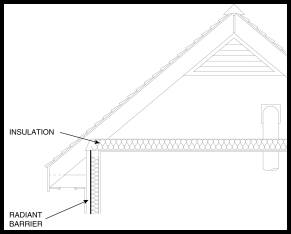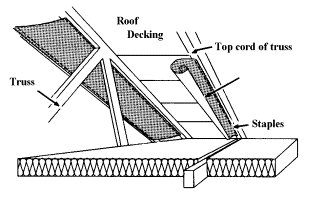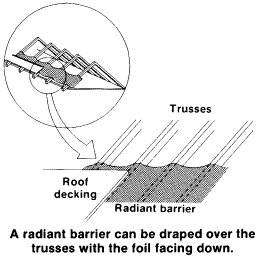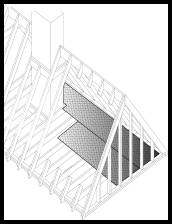Web Exclusive: Intercepting the Flow
As more people become aware of the energy crisis and the drive toward green building, the more helpful it is to find energy-efficient building products that help maximize your building’s thermal efficiency. One such product that is quickly growing in interest is a radiant barrier.

 As more people become aware of the energy crisis and the drive toward green building, the more helpful it is to find energy-efficient building products that help maximize your building’s thermal efficiency. One such product that is quickly growing in interest is a radiant barrier.
As more people become aware of the energy crisis and the drive toward green building, the more helpful it is to find energy-efficient building products that help maximize your building’s thermal efficiency. One such product that is quickly growing in interest is a radiant barrier.
A radiant barrier, as defined by the American Society of Testing & Materials (ASTM), is a reflective/low-emittance surface where the emittance is 0.10 or less on or near a building component that intercepts the flow of radiant energy to and from the building component. The thermal performance, or the reduction of radiant heat transfer, is directly proportional to the surface emittance of the radiant barrier material. Emittance measurements of all materials range between zero (0), no radiant heat transfer, and one (1) that of a black surface or complete radiant heat transfer. Common building materials, such as wood, masonry and fiberglass insulation have surface emittances of approximately 0.85 and therefore have high radiant heat-transfer rates. Products defined as radiant barriers have low radiant heat-transfer rates.
(It should be noted that a single-layer radiant barrier reduces heat loss and gain through the building envelope but is not an insulation material per se and has no inherent R-value.)
When a building section includes a radiant barrier facing an air space, this is known as a radiant barrier system (RBS). An attic with a radiant barrier on top of the mass insulation on the floor, or under the roof is an RBS. A vent skin wall with a radiant barrier facing the vented air space is also an RBS.
 The distinction between a radiant barrier “material” and radiant barrier “system” is not merely academic. In an attic, the effectiveness of a radiant barrier is significantly affected by the amount of attic ventilation. A vented attic with a radiant barrier is a very different system from an unvented attic with the same radiant barrier.
The distinction between a radiant barrier “material” and radiant barrier “system” is not merely academic. In an attic, the effectiveness of a radiant barrier is significantly affected by the amount of attic ventilation. A vented attic with a radiant barrier is a very different system from an unvented attic with the same radiant barrier.
Several types of radiant barrier materials are available. Although they all have similar surface properties (and consequently similar performance), variations in materials and construction result in significant differences with respect to strength, durability, flammability and water vapor permeability. The two most commonly available commercially are aluminum foil laminates (foil laminated to kraft paper, plastic films, or to OSB/plywood roof sheathing) and aluminized plastic films (a thin layer of aluminum particles deposited on film through vacuum process).
The most common location for a radiant barrier system is in the attic with three basic configurations used:
1. Rafter/truss installation

 2. Under, or pre-laminated to, roof sheathing
2. Under, or pre-laminated to, roof sheathing
 3. Horizontal installation (directly above ceiling and/or ceiling insulation)
3. Horizontal installation (directly above ceiling and/or ceiling insulation)
 For walls, a very effective technique is a vented skin wall using a radiant barrier. Furring strips are used to separate the outer skin from the internal structural wall. The wall is wrapped with a radiant barrier facing the vented air space. Vents are used at top and bottom to allow the heated air to rise naturally to the attic, where it is vented out through the roof vents. (Note: Radiant barriers that are non-perforated are vapor barriers. Care should be exercised with placement.)
For walls, a very effective technique is a vented skin wall using a radiant barrier. Furring strips are used to separate the outer skin from the internal structural wall. The wall is wrapped with a radiant barrier facing the vented air space. Vents are used at top and bottom to allow the heated air to rise naturally to the attic, where it is vented out through the roof vents. (Note: Radiant barriers that are non-perforated are vapor barriers. Care should be exercised with placement.)
 Radiant barriers can also be used in floor systems above unheated basements and crawl spaces. The radiant barrier is either stapled to the underside of floor joists, creating a single reflective air space, or between the joists, followed by some type of sheathing, creating two separate reflective air spaces as shown below. Radiant barriers are an ideal choice for this application because, in addition to their excellent thermal properties, they are also vapor barriers that prevent ground moisture from migrating into the living space above.
Radiant barriers can also be used in floor systems above unheated basements and crawl spaces. The radiant barrier is either stapled to the underside of floor joists, creating a single reflective air space, or between the joists, followed by some type of sheathing, creating two separate reflective air spaces as shown below. Radiant barriers are an ideal choice for this application because, in addition to their excellent thermal properties, they are also vapor barriers that prevent ground moisture from migrating into the living space above.
So, how much can radiant barriers save? Since everyone’s home and lifestyle are different, you can’t precisely calculate the personal savings you may achieve with various types of radiant barriers. Energy savings from radiant barrier systems depend on the amount of heat transfer the roof, attic, ceilings and walls contribute to your home’s heating and cooling load. In general, the more energy efficient the rest of your home is, the larger the percentage of energy you save from radiant barriers because the roof and walls make up a larger portion of your heating and cooling load. However, various university, private and government agencies have measured and reported that radiant barriers can reduce heat gain and loss through ceilings and walls by more than 70 percent and can save from 10 to 30 percent or more on heating and cooling costs in existing buildings.
Now you may be asking yourself, if radiant barriers are so beneficial, why doesn’t everyone have them? The simple answer to that is awareness. Again, as people struggle to find new ways to save energy, products like radiant barriers are coming to the forefront. What was considered good construction in the past is now not good enough as technology and new building materials are developed and prove not only to contribute to the environment but to the building owners bottom line. And even better, you will probably find that radiant barriers are one of the least costly and yet most effective conservation measures you can incorporate into your building. Manufacturers are continuing to improve radiant barrier materials, which are becoming widely available throughout the country. A radiant barrier may be installed in an existing attic or during construction of a new home. Both are relatively easy procedures. Radiant barriers meet ASTM standards for testing and installation methods for radiant barriers specifically ASTM C1313, ASTM C1158 and ASTM C168. Many manufacturers have reflective materials that have ICBO, BOCA, and SBCCI code body approvals.
For more information on radiant barriers including interior radiation control coatings (IRCCs) and reflective insulation, visit www.rimainternational.org or contact the Reflective Insulation Manufacturers Association International (RIMA-I) at 800/279-4123. If reflectives are new to you, take the time to learn more. Not only will you be doing your part to reduce energy consumption in your community, but you will create a new profit center for your business and gain more satisfied customers.
The Reflective Insulation Manufacturer's Association International exists to educate others on the benefits and uses of reflective insulation, radiant barrier and interior radiation control coating products. RIMA-I takes an active role in ASTM code standards regarding these products and has also made available an AIA/CEU test for architects and engineers at www.ronblank.com. You can find a copy of our handbook “Understanding and Using Reflective Insulation, Radiant Barriers and Interior Radiation Control Coatings” along with several of our technical bulletins, member lists and more on our website at www.rimainternational.org.


A radiant barrier, as defined by the American Society of Testing & Materials (ASTM), is a reflective/low-emittance surface where the emittance is 0.10 or less on or near a building component that intercepts the flow of radiant energy to and from the building component. The thermal performance, or the reduction of radiant heat transfer, is directly proportional to the surface emittance of the radiant barrier material. Emittance measurements of all materials range between zero (0), no radiant heat transfer, and one (1) that of a black surface or complete radiant heat transfer. Common building materials, such as wood, masonry and fiberglass insulation have surface emittances of approximately 0.85 and therefore have high radiant heat-transfer rates. Products defined as radiant barriers have low radiant heat-transfer rates.
(It should be noted that a single-layer radiant barrier reduces heat loss and gain through the building envelope but is not an insulation material per se and has no inherent R-value.)
When a building section includes a radiant barrier facing an air space, this is known as a radiant barrier system (RBS). An attic with a radiant barrier on top of the mass insulation on the floor, or under the roof is an RBS. A vent skin wall with a radiant barrier facing the vented air space is also an RBS.

Several types of radiant barrier materials are available. Although they all have similar surface properties (and consequently similar performance), variations in materials and construction result in significant differences with respect to strength, durability, flammability and water vapor permeability. The two most commonly available commercially are aluminum foil laminates (foil laminated to kraft paper, plastic films, or to OSB/plywood roof sheathing) and aluminized plastic films (a thin layer of aluminum particles deposited on film through vacuum process).
The most common location for a radiant barrier system is in the attic with three basic configurations used:
1. Rafter/truss installation





So, how much can radiant barriers save? Since everyone’s home and lifestyle are different, you can’t precisely calculate the personal savings you may achieve with various types of radiant barriers. Energy savings from radiant barrier systems depend on the amount of heat transfer the roof, attic, ceilings and walls contribute to your home’s heating and cooling load. In general, the more energy efficient the rest of your home is, the larger the percentage of energy you save from radiant barriers because the roof and walls make up a larger portion of your heating and cooling load. However, various university, private and government agencies have measured and reported that radiant barriers can reduce heat gain and loss through ceilings and walls by more than 70 percent and can save from 10 to 30 percent or more on heating and cooling costs in existing buildings.
Now you may be asking yourself, if radiant barriers are so beneficial, why doesn’t everyone have them? The simple answer to that is awareness. Again, as people struggle to find new ways to save energy, products like radiant barriers are coming to the forefront. What was considered good construction in the past is now not good enough as technology and new building materials are developed and prove not only to contribute to the environment but to the building owners bottom line. And even better, you will probably find that radiant barriers are one of the least costly and yet most effective conservation measures you can incorporate into your building. Manufacturers are continuing to improve radiant barrier materials, which are becoming widely available throughout the country. A radiant barrier may be installed in an existing attic or during construction of a new home. Both are relatively easy procedures. Radiant barriers meet ASTM standards for testing and installation methods for radiant barriers specifically ASTM C1313, ASTM C1158 and ASTM C168. Many manufacturers have reflective materials that have ICBO, BOCA, and SBCCI code body approvals.
For more information on radiant barriers including interior radiation control coatings (IRCCs) and reflective insulation, visit www.rimainternational.org or contact the Reflective Insulation Manufacturers Association International (RIMA-I) at 800/279-4123. If reflectives are new to you, take the time to learn more. Not only will you be doing your part to reduce energy consumption in your community, but you will create a new profit center for your business and gain more satisfied customers.
The Reflective Insulation Manufacturer's Association International exists to educate others on the benefits and uses of reflective insulation, radiant barrier and interior radiation control coating products. RIMA-I takes an active role in ASTM code standards regarding these products and has also made available an AIA/CEU test for architects and engineers at www.ronblank.com. You can find a copy of our handbook “Understanding and Using Reflective Insulation, Radiant Barriers and Interior Radiation Control Coatings” along with several of our technical bulletins, member lists and more on our website at www.rimainternational.org.
Looking for a reprint of this article?
From high-res PDFs to custom plaques, order your copy today!



